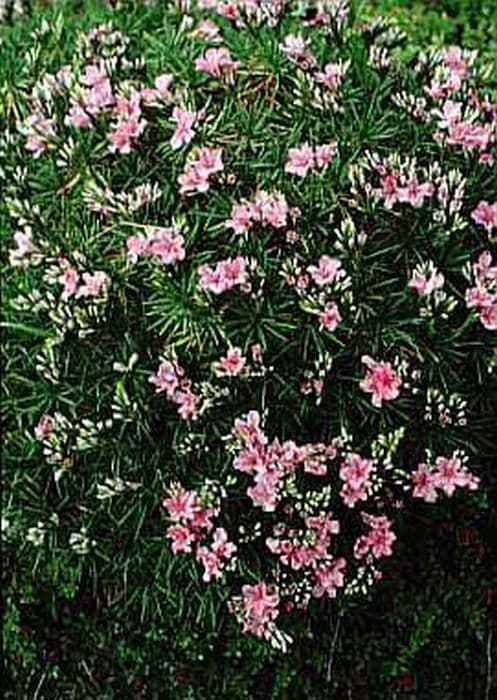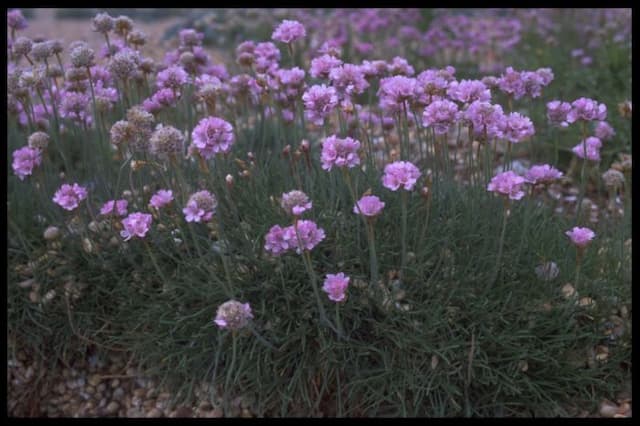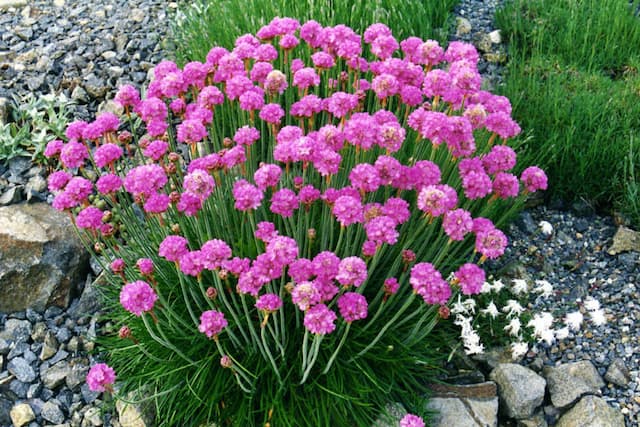Thrift Armeria maritima 'Nifty Thrifty' (v)

ABOUT
The plant known as 'Nifty Thrifty' has a unique and decorative appearance. Its foliage is notable for the variegated pattern, featuring green leaves distinctly edged with creamy white borders, giving it a vibrant and striking appearance. The leaves themselves are narrow, resembling grass blades, and form a dense tuft which can be both lush and compact. This plant blooms with spherical clusters of small, pink to lavender flowers, which rise above the foliage on slender stalks. The flowers contribute to its ornamental appeal, especially when they appear in late spring to early summer, adding a splash of color and a delicate, soft texture to the plant's overall presentation. These flowering stems could potentially attract butterflies and other pollinators, while also offering a contrast to the variegated foliage beneath. Overall, 'Nifty Thrifty' presents itself as an attractive garden plant with its variegated leaves and charming blooms.
About this plant
 Names
NamesFamily
Plumbaginaceae
Synonyms
Thrift, Sea Pink, Sea Thrift
Common names
Armeria maritima 'Nifty Thrifty'.
 Toxicity
ToxicityTo humans
The plant commonly known as thrift or sea thrift, including the cultivar Armeria maritima 'Nifty Thrifty', is not known to be toxic to humans. It is generally considered safe and there are no well-documented adverse effects or symptoms associated with ingesting this plant.
To pets
Thrift, including the Armeria maritima 'Nifty Thrifty' variety, is not commonly known to be toxic to pets either. It is considered non-toxic to cats, dogs, and horses, and ingestion of this plant should not cause any significant symptoms of poisoning in domestic animals. However, it is always prudent to monitor pets and prevent them from eating large quantities of any non-food plants, as they could potentially cause gastrointestinal upset simply due to being non-digestible matter.
 Characteristics
CharacteristicsLife cycle
Perennials
Foliage type
Evergreen
Color of leaves
Variegated
Flower color
Pink
Height
0.5 feet (15 cm)
Spread
1 foot (30 cm)
Plant type
Herb
Hardiness zones
4
Native area
Europe
Benefits
 General Benefits
General Benefits- Drought resistant – This plant is highly suitable for low-water gardens, as it can withstand dry conditions once established.
- Low maintenance – It requires minimal care, making it ideal for gardeners seeking a low-effort plant.
- Tolerates poor soil – Armeria maritima 'Nifty Thrifty' can grow in poor soil conditions, including sandy and rocky substrates.
- Attracts pollinators – It draws in bees, butterflies, and other beneficial insects, supporting local ecosystems.
- Sea thrift is salt tolerant – It thrives in coastal areas where salt spray from the sea would damage many other plants.
- Compact size – Its small, neat growth habit makes it perfect for border edges, rock gardens, and small spaces.
- Erosion control – Its dense mat-forming nature helps to stabilize soil and prevent erosion.
- Long blooming season – Sea thrift offers a long season of color with its extended blooming period.
- Evergreen foliage – It maintains its foliage year-round, providing winter interest in the garden.
 Medical Properties
Medical PropertiesThis plant is not used for medical purposes.
 Air-purifying Qualities
Air-purifying QualitiesThis plant is not specifically known for air purifying qualities.
 Other Uses
Other Uses- Edging for walkways: The compact growth pattern of Armeria maritima 'Nifty Thrifty' suits it well for creating tidy borders along garden paths or walkways.
- Accent in rock gardens: Its grass-like variegated foliage and pink flowers provide a contrast in texture and color in rock garden arrangements.
- Container Gardening: The plant's size and adaptability to various conditions make it suitable for potting in containers for patios or balconies.
- Seaside Themed Landscapes: As a seaside plant, it contributes to the aesthetic of coastal-themed gardens, even in inland areas.
- Ground Cover: It can be used to fill in small areas of the garden where grass might otherwise be grown, providing a more colorful and low-maintenance alternative.
- Rooftop Gardens: Its tolerance for windy and salty conditions makes it an excellent choice for rooftop gardens in urban coastal areas.
- Butterfly Gardens: The flowers can attract butterflies and other pollinators, making it a beneficial addition to such gardens.
- Salt Tolerant Planting: For areas with saline soil or near salted roadways, this plant can thrive where others may struggle.
- Crafting: The dried flower heads can be used in floral arrangements or crafts due to their sturdy and attractive form.
- Pressing: Flowers of Armeria maritima 'Nifty Thrifty' can be pressed for use in botanical art or as a technique for preserving them for educational purposes.
Interesting Facts
 Feng Shui
Feng ShuiThe plant Sea Thrift is not used in Feng Shui practice.
 Zodiac Sign Compitability
Zodiac Sign CompitabilityThe plant Sea Thrift is not used in astrology practice.
 Plant Symbolism
Plant Symbolism- Resilience: Armeria maritima, commonly known as Thrift or Sea Thrift, typically grows in tough coastal conditions, symbolizing the ability to withstand challenging environments and bounce back.
- Prosperity: The name "Thrift" suggests frugality and saving, metaphorically translating to the idea of flourishing or prospering in various areas of one's life.
- Adaptability: Thrift plants are adaptable to various soil types and conditions, symbolizing the trait of being versatile and flexible in life's circumstances.
- Longevity: Being a perennial plant, Thrift symbolizes long-lasting life, endurance, and the continuation of presence through the seasons.
- Endearment: The compact, round shapes of Thrift flowers evoke a sense of affection and charm, making it a symbol of tender emotions and warmth in relationships.
 Water
WaterThrift (Sea Pink) prefers to be watered deeply but infrequently, ensuring that the soil has time to dry out slightly between waterings. Typically, watering once a week with about one to one and a half gallons of water per plant is adequate, but this can vary depending on your local climate and soil conditions. They are drought-tolerant once established, so be careful not to overwater, as they don't like to sit in wet soil. During hot or dry spells, you may need to water more frequently, and less often during cooler or rainy periods. Always check the top inch of soil for dryness before watering again.
 Light
LightThrift (Sea Pink) thrives in full sun to part shade conditions, with a preference for a spot that receives at least six hours of direct sunlight daily. They perform best in bright light where they can receive ample sun exposure throughout the day. In regions with very hot summers, a location with afternoon shade can help prevent scorching of the foliage.
 Temperature
TemperatureThrift (Sea Pink) can endure a wide range of temperatures and is hardy in USDA zones 3 to 8. They can survive minimum temperatures down to -40 degrees Fahrenheit and are well-suited to coastal climates, reflecting their maritime origin. The ideal temperature range for thriving Sea Pink is between 60 and 75 degrees Fahrenheit, but they are adaptable to cooler and warmer conditions as long as the soil is well-draining.
 Pruning
PruningThrift (Sea Pink) should be pruned to remove spent flower stalks and to encourage a tidy growth habit. Deadhead the flowers after they fade to promote a second bloom. In early spring, as new growth begins, trim back any dead or discolored foliage from the previous year. Pruning is typically done once a year, and the best time for this is after the blooming cycle has ended or in early spring.
 Cleaning
CleaningNot needed
 Soil
SoilThrift (Sea Pink) prefers well-draining soil with a mix of sand, peat, or other organic matter to enhance drainage. The ideal pH for Thrift is slightly acidic to neutral, between 5.5 and 7.5. A mixture that provides good aeration and drainage while still holding some moisture will support its growth best.
 Repotting
RepottingSea Pink should be repotted every 2-3 years to refresh the soil and accommodate root growth. It's best done in spring or early summer, just as the plant begins to enter its active growth phase.
 Humidity & Misting
Humidity & MistingSea Pink tolerates a range of humidity levels but thrives best in moderate conditions. It's naturally adapted to coastal areas, so it doesn't require high humidity environments and handles drier conditions well.
 Suitable locations
Suitable locationsIndoor
Ensure bright light, well-draining soil, and don’t overwater.
Outdoor
Plant in full sun, well-drained soil, and space 6-12 inches apart.
Hardiness zone
4-8 USDA
 Life cycle
Life cycleSea Pink 'Nifty Thrifty' begins its life cycle as a seed, sown in well-draining soil in early spring or propagated by division. Upon germination, the seed develops into a small rosette of variegated, white-edged green grass-like foliage, which gradually matures and becomes denser. In late spring to early summer, the plant produces sturdy, erect stems that bear clusters of pink, globe-like flowers well above the foliage. After blooming, which can last several weeks, the flowers fade and seed capsules may form if pollinators have visited the blooms. As a perennial, Sea Pink 'Nifty Thrifty' will die back in the fall or after the first hard frosts, with the roots surviving the winter to regenerate foliage the following spring. This cycle repeats annually, with the plant gradually expanding in size and sometimes requiring division every few years to maintain vigor.
 Propogation
PropogationPropogation time
Spring to early summer
Armeria maritima 'Nifty Thrifty', commonly known as Sea Thrift or Sea Pink, is best propagated through division. The ideal time for dividing this perennial is in spring or early fall, when the plant is not in active bloom. To propagate, carefully lift the entire plant from the ground using a garden fork, ensuring to keep as much of the root system intact as possible. Gently separate the plant into smaller clumps, making sure each new section has several growing points and a portion of the root system. These divisions can then be immediately replanted into a well-draining soil mix at the same depth they were growing previously, watered in well and kept moist until they become established.









